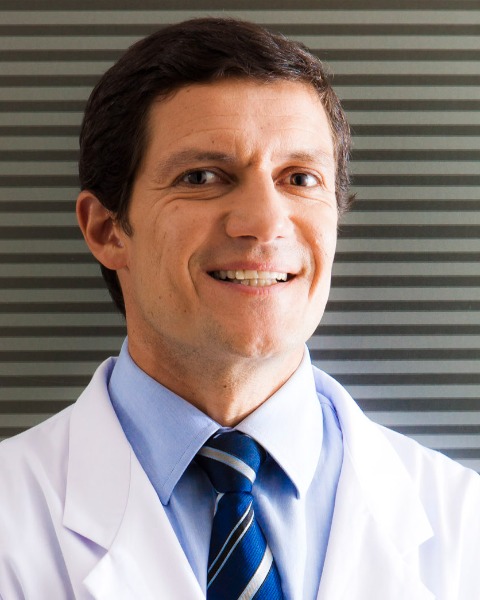Back
Poster, Podium & Video Sessions
Podium
PD19: Stone Disease: Surgical Therapy (including ESWL) II
PD19-05: Basketing versus Dusting Lithotripsy for Kidney Stones during Flexible Ureteroscopy: Randomized Controlled Trial and Computerized Tomography Follow Up
Saturday, May 14, 2022
7:40 AM – 7:50 AM
Location: Room 245
Alex Meller*, Rafael Astolfi, Gustavo Freschi, Raphael Carrera, Marcus Sadi, São Paulo, Brazil

Alex E. Meller, MD,PhD
Federal University of Sao Paulo
Podium Presenter(s)
Introduction: There is still lack of high-quality evidence in the literature to support active basketing extraction versus dusting during flexible ureteroscopy for kidney stones. We assessed prospectively and randomly patients submitted to both modalities and followed then with the more accurate image to determine which technique produced a higher stone free rate with the fewest complications.
Methods: A total of 100 patients undergoing flexible ureteroscopy and holmiun laser lithotripsy for renal stones between 5 to 20 mm were randomized to active fragments extraction (Group 1) or stone dusting and spontaneous fragments passage (group 2). Except for lithotripsy strategy, all the surgical parameters were identical. Ureteral access sheaths were used in all cases. The primary outcome was the stone free rate (SFR) at 90 days as determined by computerized tomography for residual fragments = 2mm. The secondary outcome was the influence of stone volume and density in the two modalities and complication rates between the two groups.
Results: A total of 93 patients completed the protocol, 45 in group 1 and 48 in group 2. Patients in group 2 were older (48 vs. 42, p = 0,027) and all other demographic characteristics were comparable. Number of pre-stented patients and stone diameter, density, volume and location (inferior pole and non-inferior pole) were similar in both groups. The mean stone diameter and volume were 13,4 ± 4,7 mm and 484 ± 403 mm3, respectively. The SFR was not significantly different between groups (66,7 vs. 68,8% - p = 0,751) and multivariate analysis revealed that higher BMI was associated with better SFR (1,17 OR 95% IC 1,02 – 1,34, p = 0,022). Stone volume (p = 0,179) and density (p = 0,884) did not influence the SFR on univariate analysis between the two modalities of fragmentation. There were no statistically significant differences in operative time, complication rates or ancillary procedures between groups.
Conclusions: The stone free rate was comparable for active fragments basketing or stone dusting and spontaneous fragment passage during flexible ureteroscopy with holmiun laser lithotripsy on 90 days follow up. There was no influence of stone volume and density in both modalities. Post-operative complication rates and need of ancillary procedures were similar between groups. Both fragmentation techniques are efficacious and could be performed according to surgeon’s preference.
Source of Funding: None
Methods: A total of 100 patients undergoing flexible ureteroscopy and holmiun laser lithotripsy for renal stones between 5 to 20 mm were randomized to active fragments extraction (Group 1) or stone dusting and spontaneous fragments passage (group 2). Except for lithotripsy strategy, all the surgical parameters were identical. Ureteral access sheaths were used in all cases. The primary outcome was the stone free rate (SFR) at 90 days as determined by computerized tomography for residual fragments = 2mm. The secondary outcome was the influence of stone volume and density in the two modalities and complication rates between the two groups.
Results: A total of 93 patients completed the protocol, 45 in group 1 and 48 in group 2. Patients in group 2 were older (48 vs. 42, p = 0,027) and all other demographic characteristics were comparable. Number of pre-stented patients and stone diameter, density, volume and location (inferior pole and non-inferior pole) were similar in both groups. The mean stone diameter and volume were 13,4 ± 4,7 mm and 484 ± 403 mm3, respectively. The SFR was not significantly different between groups (66,7 vs. 68,8% - p = 0,751) and multivariate analysis revealed that higher BMI was associated with better SFR (1,17 OR 95% IC 1,02 – 1,34, p = 0,022). Stone volume (p = 0,179) and density (p = 0,884) did not influence the SFR on univariate analysis between the two modalities of fragmentation. There were no statistically significant differences in operative time, complication rates or ancillary procedures between groups.
Conclusions: The stone free rate was comparable for active fragments basketing or stone dusting and spontaneous fragment passage during flexible ureteroscopy with holmiun laser lithotripsy on 90 days follow up. There was no influence of stone volume and density in both modalities. Post-operative complication rates and need of ancillary procedures were similar between groups. Both fragmentation techniques are efficacious and could be performed according to surgeon’s preference.
Source of Funding: None

.jpg)
.jpg)